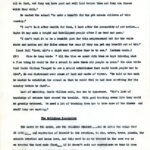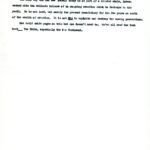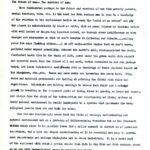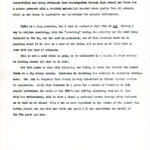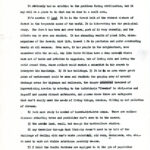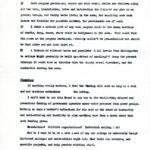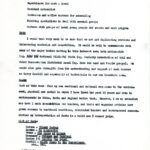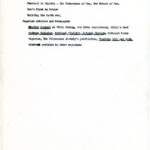Pine Mountain Settlement School
Series 09: BIOGRAPHY
Series 11: LAND USE
Mary Rogers
Staff
Uncle William’s Mandate to Pine Mountain
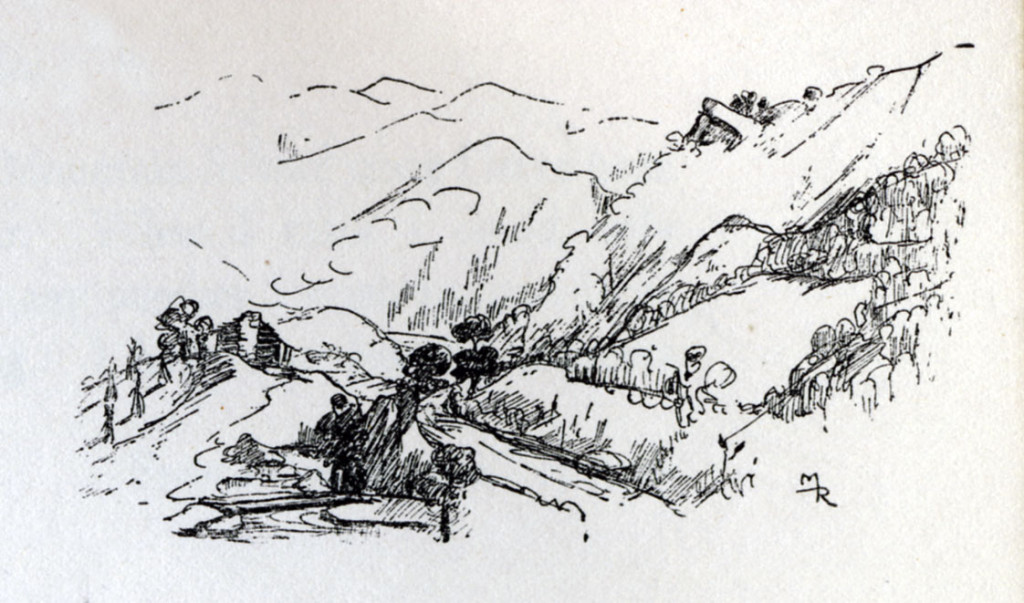
1945 Calendar. Drawing by Mary Rogers, May. “Think of the thousands of miles of mountains ….” [cale_1945_007-1]
TAGS: Mary Rogers, Uncle William’s Mandate to Pine Mountain, William Creech, educational programming, environmental education, ecological research, conservation of national resources, local wisdom, abuse of environment, strip mines, population control, resident naturalists, Bill Hayes, Bob Stepherd, local culture, library, funding, Harry Caudill, Save the Land and People, publications about ecology and conservation
MARY ROGERS 1969 Uncle William’s Mandate to Pine Mountain, 1969
A planning document submitted by Mary Rogers for educational programming at Pine Mountain Settlement School, prepared in October of 1969, now sits at the heart of environmental education at the School.
Perhaps inspired by Mary’s close connection with the earth and her deep religiosity formed by her work in India and in China, she states,
The only way man can see himself today is as part of a created whole, intermeshed with the delicate balance of an on-going creation which he destroys to his peril. He is not lord, but merely the present beneficiary for his few years on earth of the wealth of creation. It is not his to exploit and destroy for coming generations.
Mary Rogers
Mary then continues to expand on Uncle William Creech‘s “mandate” by offering a full description of the NEED at Pine Mountain for an environmental education program. She follows that thread with an outline of WHAT PINE MOUNTAIN HAS TO OFFER. She describes the envisioned program as serving ecological research, adult education, youth education, and a strong research base served up in the rural environment. FINANCING, she believes, will follow as the merits of the program are realized. She outlines staffing, research resources, and the importance of a strong BASE OF SUPPORT in staffing and in research resources with the natural environment of Pine Mountain at the center.
TRANSCRIPTION: MARY ROGERS 1969 Uncle William’s Mandate to Pine Mountain
UNCLE WILLIAM’S MANDATE TO PINE MOUNTAIN
[NOTE: The following text has been slightly edited for readability.]
001
1915 “I want all young’uns taught to serve the living God. Of course, they won’t all do that, but they can have good and evil laid before them and they can choose which they will.”
He wanted the school “to make a benefit for the yet unborn children of this country.”
“I don’t look after wealth for them, I look after the prosperity of our nation… Hopin’ it may make a bright and intelligent people after I am dead and gone.”
“I don’t want it to be a benefit just for this neighborhood but for the whole state and nation and for folks across the seas if they can get any benefit out of hit.”
(Aunt Sal) “Lord, hit’s a sight what pretties thar be to see.” (autumn woods.)
1911 Miss [Ethel] de Long wrote “All the time we spent with them we kept thinking what a fine thing it would be for a school to have these old people so near.” She also wrote that Uncle William “longed to see a school established that would teach people how to live.” He was distressed over abuse of land and waste of timber. “He told us how much he wanted to establish the school so that he could feel he had done something for his country before he died.”–
Lack of morality, Uncle William said, was due to ignorance. “Hit’s lack of knowledge of science that caused the trouble. With good teaching seems like they would be greatly bettered. We need a lot of teaching them how to take care of the timber and stuff they are wasting.”
The Religious Imperative
THE EARTH IS THE LORD’S, AND THE FULLNESS THEREOF….GOD SO LOVED THE WORLD THAT HE GAVE__ an expression of himself in the creation, in air, water, trees, plants, the animate creation and human love, and this word to us is treated in the same way as we treated the Word made flesh__if it doesn’t suit our convenience we tear it down to minister to our greed and private ambitions.
002
The only way man can see himself today is as part of a created whole, intermeshed with the delicate balance of an on-going creation which he destroys to his peril. He is not lord, but merely the present beneficiary for his few years on earth of the wealth of creation. It is not his to exploit and destroy for coming generations.
One could write pages on this but one doesn’t need to. We’ve all read the text book__The Bible, especially the New Testament.
003
The Need
The future of man– The survival of man–
More fundamental perhaps to the future and survival of man than poverty pockets, racial tensions, wars, etc. is the need for 20th century man to come to a knowledge of his relation to his environment before we reach the “point of no return” and the planet is uninhabitable by black or white, rich or poor, Chinese or Russian; before, with evil intent or do-gooding ignorant intent or through sheer indifference, we have changed our atmosphere so that we can’t breathe it, (altering our climate….melting polar ice caps flooding cities….) [set?] off [radio?]-active chains that we can’t check, polluted water beyond potability, debased the earth’s soil, over-populated the world, eliminated basic [lines?] in the chain of life, paved under the green world with asphalt and concrete roads that the future will not need, buried ourselves in our own garbage dumps, let loose intolerable sonic booms with no knowledge of their physical impact on the biosphere, etc., etc. Books and news media are hammering the story home. City, state, and national governments are toiling at patching the fabric with rules and regulations. Scientists are holding meetings to stress that, while our knowledge gained by breaking up the component parts of living items is growing by leaps and bounds, our wisdom from the study of the inter-action and relationship of living systems in their natural environment is wholly inadequate to a species that possesses the technological powers that are our tools for today,
One becomes increasingly aware that the field of ecology, understanding our natural environment not as a grab-bag of dollar-earning resources but as the framework within which alone it is possible (even for a dollar earner) to survive, is of paramount importance, and a love and deeper understanding of it is essential not only to government departments and college biologists but to every individual. It is a basic part of the equipment with which a person should face life in the 20th and 21st century, armed as we are with technological power to exploit and change.
004
One’s feeling of inner dismay and horror cries out, “What can I do?” The recent exhibition at the American Museum of Natural History, “Can Man Survive,” highlighted all the dangers to the environment against a blare of recorded voices. “You can’t fight the system,” “This is a free country,” “There isn’t anything I can do about it,” etc… and as people left the exhibit they were brought face to face with a mirror. “This is the only person who can do anything about it.”
People Who Are Doing Something
Government departments, research organizations of some industries (T.V.A.), The Wilderness Society, World Wildlife Federation, National Wildlife, Sierra Club, State Reclamation Services, Planned Parenthood, The Environmental Defense Fund (fighting legal cases), and on and on down to local groups like the Save the Land and People groups in Knott County.
Teachers, 4H Clubs, Scouts, some county agents (though often the guidelines handed out to them are based on insufficient knowledge and study in the use of pesticides). Individuals who own forest land they are trying to care for, who refuse right-of-way to strip-mines to keep the environment clean.
On all these levels something is being done.
The Kentucky Association of Soil and Water Conservation Districts recently made the following recommendations:
“They voted to ask the 1970 legislature for $50,000 to develop a curriculum on conservation education for the state’s public schools and asked the University of Kentucky to give high priority to the development of a natural resources school to include forestry, wildlife, and recreation divisions.” (Quoted from the Courier Journal, Oct. 1969)
Some states, e,g., Connecticut and California, as far back as 1952 at least, have curriculum units on the conservation of national resources.
005
Audubon Magazine had an article on a program at Ann Arbor where curriculum on conservation was being developed from kindergarten through high school and there was a nature preserve with a resident naturalist teacher where pupils from all schools could go and learn to appreciate and understand the natural environment.
This is a long preamble, but I want to emphasize that this in not finding a way to utilize something, with the “something” having the priority and the need being tailored to fit it, but the need is paramount, and if Pine Mountain wants to do anything about it it will be a case of its biting off as much as it feels able to chew with any hope of adequacy.
This is not a need which is going to be eliminated in a couple of years leaving us looking around for what to do next.
Red Bird [Mission] plans to deal with dropouts and trying to serve the student who cannot learn in a big county school. Henderson is directing its services to community development. The John C. Campbell Folk School is very interested in intern student service in Appalachia. Would Pine Mountain be a place for a center of education to help people understand the world of the 1970’s and 1980’s, educating them how to live with the environment, able to make a stand on national issues through being informed as to what is at stake? This I see as more important to the future of the planet than having people who can read and write and spell ( if not understand the words) of the 8th grade speller.
006
What Does Pine Mountain Have to Offer?
It obviously has no solution to the problems facing civilization, but it may well be a place to do what can be done in a small area.
Its assets: 1) Land It is in the forest belt of the richest mixture of forest in the temperate zones of the world. It is interesting too for geological study. The forest has been cut over twice, part of it very recently, and the effects can be seen and studied. It has [an] wealth of plant life, microorganisms of the forest; bird life, insect life in profusion, and quite outstanding beauty at all seasons. Even more, it has people in the neighborhood, some connected with the school, who like Uncle William have a deep natural wisdom born not of books and articles in magazines, but of living with and loving the world around them, whose outlook would enrich a scientist in his search to interpret his knowledge. 2) It has buildings. 3) It is an area where great abuse of environment could be seen and studied – the gouging away of natural drainage areas for highways and railroads, the danger incurred of impoverishing America by catering to the individual’s “freedom” to strip-mine and log-off and quarry without safeguards, and places where there are safeguards that don’t really meet the needs of living things, erosion, filling up and pollution of streams.
4) Much more study is needed of insect-bird-tree nexus. There are endless diseases attacking trees and pesticides don’t seem to be the answer.
5) The arable land, small, but enough for horticulture studies.
6) Any traveler through East Kentucky doesn’t need to be told of the challenge of dealing with man’s waste products, old cars, containers, etc. etc. We need to work out viable solutions – possibly re-use.
7) I think the Health Services are equipped to do the job of population control, but educational side of this is part of the necessary study.
007
What Kind of Program?
1) People who want to do ecological research stay here and do it. College teachers and students, interested citizens, amateur naturalists – perhaps not many. Labs of existing colleges could be used. (Affiliation with the Science Department of South East Center for lab and library?) College which are co-operating on some things might help sponsor. Picture collections, specimen collections, could in time work up a museum of the Southern Mountains (where else is this being done?)
2) Adult Education. Ministers and rural church workers on subjects such as “co-operation with God in loving care of His world.” Local groups on some subject like TVA watershed improvement studies, extension of Save the Land and People groups. A bus would be needed to bring people in and take them out to study reclamation, orphan spoil banks, work camps of students to work on “menial” tasks not suited to Happy Pappies such as helping clean out creek channels. (Isn’t government offering help with deepening?)
3) Main emphasis on Youth Education (the fourth basic beside the 3 R’s (see Ann Arbor experiment), A) Develop curriculum material by finding out what concerned teachers in the area have already done and using the ideas of some new-comers to the area to supplement the experiences of old-timers. Tours to strip banks, garbage disposal, etc., would be part of the curriculum. B) Holding teachers’ seminars on “understanding the environment.” (I don’t say conservation as this may be interpreted as teaching how to use a gun or a fishing rod, which is a small part and a point of entry into the whole subject because it has high interest priority.
4) The availability of a resident Naturalist for the county schools in this and adjoining counties to conduct field education for groups of school children. (See Ann Arbor experiment – I envisage someone like Bill Hayes, though I know there are not many people like him to be found), possible week-end camps the year round organized by teachers, scout leaders, 4H workers, churches, from among their students to study some special aspect, with tours providing supplemen-
008
tary education. Use West Wind – develop campsite.
5) Continued sponsoring of the scouts
6) Work program greenhouse, summer and year round, adults and children using all the help, inspiration, drive, and information Bob Stepherd can give us on growing things, for family berre[?] living in the area, for supplying some cash income for families for possible markets, for permissible use of land.
7) I think a natural part of any such program would be the human heritage of crafts, song, dance, story which is indigenous to the area. This would find its place as the program developed. Probably couldn’t be pre-scheduled but should be kept alive and not lost sight of.
8) A library of relevant books and pamphlets at all levels from kindergarten to college might gradually be built up – Method of handling??? Scrap the present library – it would have no function with the county school elsewhere – and the bookmobile serving the area.
Financing
If anything really matters, I feel the funding will come as long as a real and not spurious enthusiasm … the asking. I don’t want to see this bound in any way to the vacillating, delayed, and precarious funding of government agencies under voter pressure from power groups. Nothing so saps a worker’s enthusiasm for his work as the sense of insecurity and sail-trimming and inability to plan anything more than a month ahead that such funding gives.
Foundations? Wildlife organizations? Individual mailing list?
Nor do I want it to be a side annex of any one college or university, though different colleges and universities might help find their own students, and specific projects, and help provide visiting staff.
009
Staff Needed
Maintenance and catering crews, cleaning crews – local supervisors for work – local
resident naturalist
Hostesses and office workers for scheduling
Visiting specialists to deal with special groups
Workers with groups of local young people for Scouts and work program
Note
I would want very much to be sure that we are not duplicating services and introducing confusion and competition. It would be well to communicate with many of the major bodies working in this interest area, both nation-wide (e.g., National Wildlife), State (e.g., Kentucky Association of Soil and Water Conservation Districts), local (e.g., Save the Land and People groups). We would also gain strength from the understanding and support of such leaders as Harry Caudill and especially of individuals in our own immediate area.
Books
Most of this comes from my own emotional and rational responses to the environment, physical and social, in which I have lived the past 25 years and even to environments in China, India, and England before that. However, I am no scientist nor have I much documentation for hunches, and books and magazine articles have given reasons to emotional reactions, documented hunches, and corroborated concern – whether my interpretation of facts is a valid one I cannot judge.
List of Books
Carson – Silent Spring
Lorenz – On Aggression
Bonne – The Scale of Nature
Commoner – Science and Survival
Marive (?) – America the Raped
Caudill – Night Comes to the Cumberlands
etc., etc.
Children’s Books:
Wildlife in Dancer, Wildlife of Australia, Wildlife of Africa, In the Wake of the Whale, Endangered Wild Life, Land of the Hibernating Rivers
010
Religious Books:
Trahune Centuries
Pierre Teilhard de Chardin – The Phenomenon of Man, [and] the Future of Man
Man’s Place in Nature
Building the Earth, etc.
Magazine Articles and Newspapers:
Courier Jounal on Strip Mining, Red River controversy, Lilly’s Wood,
Audubon Magazine, National Wildlife, Natural History, National Parks
magazine, The Wilderness Society’s publication, Mountain Life and Work.
Relevant articles in other magazines.
GALLERY: MARY ROGERS Uncle William’s Mandate to Pine Mountain
- 01 rogers_m_1969_uncle_wms_mandate_001
- 02 rogers_m_1969_uncle_wms_mandate_002
- 03 rogers_m_1969_uncle_wms_mandate_003
- 04 rogers_m_1969_uncle_wms_mandate_004
- 05 rogers_m_1969_uncle_wms_mandate_005
- 06 rogers_m_1969_uncle_wms_mandate_006
- 07 rogers_m_1969_uncle_wms_mandate_007
- 08 rogers_m_1969_uncle_wms_mandate_008
- 09 rogers_m_1969_uncle_wms_mandate_009
- 10 rogers_m_1969_uncle_wms_mandate_010
SEE ALSO
MARY ROGERS Staff
MARY ROGERS Similitudes
LOREN KRAMER Staff
NANCY SATHER Staff and Trustee
ENVIRONMENTAL EDUCATION Guide

